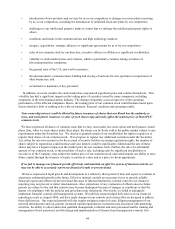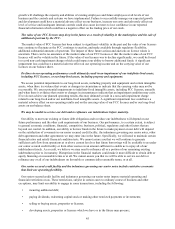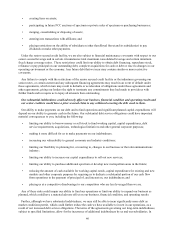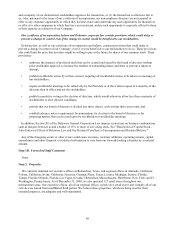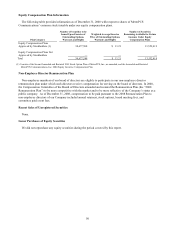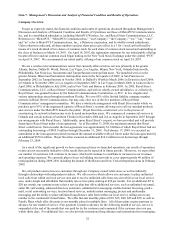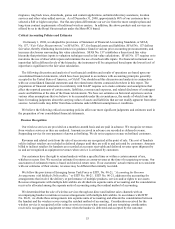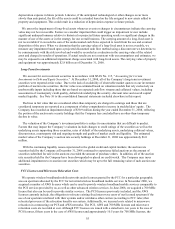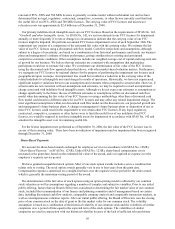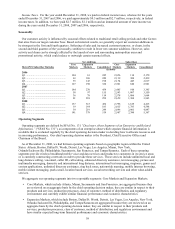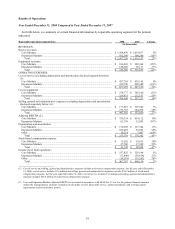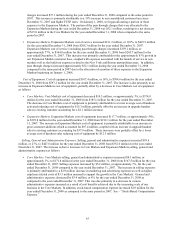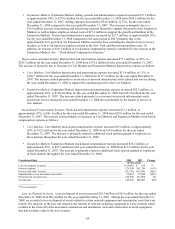Metro PCS 2008 Annual Report Download - page 63
Download and view the complete annual report
Please find page 63 of the 2008 Metro PCS annual report below. You can navigate through the pages in the report by either clicking on the pages listed below, or by using the keyword search tool below to find specific information within the annual report.54
Allowance for Uncollectible Accounts Receivable
We maintain allowances for uncollectible accounts for estimated losses resulting from the inability of our
independent retailers to pay for equipment purchases and for amounts estimated to be uncollectible for intercarrier
compensation. We estimate allowances for uncollectible accounts from independent retailers based on the length of
time the receivables are past due, the current business environment and our historical experience. If the financial
condition of a material portion of our independent retailers were to deteriorate, resulting in an impairment of their
ability to make payments, additional allowances may be required. In circumstances where we are aware of a specific
carrier’s inability to meet its financial obligations to us, we record a specific allowance for intercarrier compensation
against amounts due; to reduce the net recognized receivable to the amount we reasonably believe will be collected.
Total allowance for uncollectible accounts receivable as of December 31, 2008 was approximately 12% of the total
amount of gross accounts receivable.
Inventories
We write down our inventory for estimated obsolescence or unmarketable inventory equal to the difference
between the cost of inventory and the estimated market value or replacement cost based upon assumptions about
future demand and market conditions. Total inventory reserves for obsolescent and unmarketable inventory were
not significant as of December 31, 2008. If actual market conditions are less favorable than those projected,
additional inventory write-downs may be required.
Deferred Income Tax Asset and Other Tax Reserves
We assess our deferred tax asset and record a valuation allowance, when necessary, to reduce our deferred tax
asset to the amount that is more likely than not to be realized. We have considered future taxable income, taxable
temporary differences and ongoing prudent and feasible tax planning strategies in assessing the need for the
valuation allowance. Should we determine that we would not be able to realize all or part of our net deferred tax
asset in the future, an adjustment to the deferred tax asset would be charged to earnings in the period we made that
determination.
We establish reserves when, despite our belief that our tax returns are fully supportable, we believe that certain
positions may be challenged and ultimately modified. We adjust the reserves in light of changing facts and
circumstances. Our effective tax rate includes the impact of income tax related reserve positions and changes to
income tax reserves that we consider appropriate. A number of years may elapse before a particular matter for which
we have established a reserve is finally resolved. Unfavorable settlement of any particular issue may require the use
of cash or a reduction in our net operating loss carryforwards. Favorable resolution would be recognized as a
reduction to the effective rate in the year of resolution. Tax reserves as of December 31, 2008 were $37.6 million of
which $5.2 million and $32.4 million are presented on the consolidated balance sheet in accounts payable and
accrued expenses and other long-term liabilities, respectively.
On January 1, 2007, we adopted FASB Interpretation No. 48 “Accounting for Uncertainty in Income Taxes,” or
FIN 48. FIN 48 clarifies the accounting for uncertainty in income taxes recognized in the financial statements in
accordance with SFAS No. 109. FIN 48 provides guidance on the financial statement recognition and measurement
of a tax position taken or expected to be taken in a tax return. FIN 48 also provides guidance on derecognition,
classification, interest and penalties, accounting in interim periods, disclosures, and transition. FIN 48 requires
significant judgment in determining what constitutes an individual tax position as well as assessing the outcome of
each tax position. Changes in judgment as to recognition or measurement of tax positions can materially affect the
estimate of the effective tax rate and consequently, affect our operating results.
Property and Equipment
Depreciation on property and equipment is applied using the straight-line method over the estimated useful lives
of the assets once the assets are placed in service, which are seven to ten years for network infrastructure assets,
three to ten years for capitalized interest, three to seven years for office equipment, which includes computer
equipment, three to seven years for furniture and fixtures and five years for vehicles. Leasehold improvements are
amortized over the shorter of the remaining term of the lease and any renewal periods reasonably assured or the
estimated useful life of the improvement, whichever is shorter. The estimated life of property and equipment is
based on historical experience with similar assets, as well as taking into account anticipated technological or other
changes. If technological changes were to occur more rapidly than anticipated or in a different form than anticipated,
the useful lives assigned to these assets may need to be shortened, resulting in the recognition of increased


